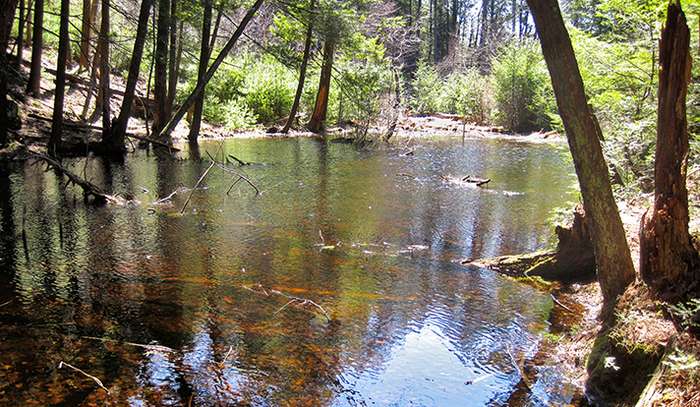Small ponds produce an outsized share of greenhouse gases

Tiny ponds play a disproportionately large role in global greenhouse gas emissions from inland waters, according to a new study by Yale's School of Forestry & Environmental Studies.
Although ponds less than a quarter of an acre in size make up only 8.6% of the surface area of the world's lakes and ponds, they account for 15.1% of carbon dioxide (CO2) emissions and 40.6% of diffusive methane (CH4) emissions. The findings appear in the Feb. 1 online edition of the journal Nature Geoscience.
"Our study is the first to include these small ponds in global estimates of CO2 and CH4 emissions, largely because they are difficult to map and were thought to play a small role in carbon cycling," said Yale doctoral student Meredith Holgerson, the study's lead author.
Holgerson and co-author Peter Raymond, professor of ecosystem ecology at Yale, conducted their analysis by combining recent estimates on the global number of lakes and ponds with a compilation of direct measurements of CO2 and CH4 concentrations from 427 lakes and ponds. They found that concentrations were greatest in smaller ponds and decreased as the ponds and lakes grew larger.
The reason has to do with the physical makeup of very small ponds and the way they cycle carbon. Small ponds have a high perimeter-to-surface-area ratio, for example, and accumulate a higher load of terrestrial carbon—so-called "leaf litter," sediment particles and other material. Small ponds also tend to be shallow, which means their terrestrial carbon loads are highly concentrated compared to larger lakes. Lastly, gases produced at the bottom of these ponds are able to reach the top more often than what occurs in larger lakes, due to greater water mixing and shallower waters. Because of this, CO2 and CH4 generated in sediments affects the entire pond.
"That makes small ponds an important player in the carbon cycle," Holgerson said.
The findings warrant additional research to more accurately estimate the number of tiny ponds around the world, she added. Such spots don't typically show up on satellite images, but they can be mapped using aerial images and LiDAR, a remote sensing technology that uses reflected laser light. The researchers also said their findings suggest that small ponds are likely breaking down terrestrial carbon that is not factored into assessments of the world's carbon stocks and fluxes.
"The carbon cycling that happens in freshwater systems needs to be accounted for in estimates of terrestrial production," Holgerson said. "These numbers are important to quantifying the global carbon cycle and making predictions about future stocks and flows of carbon."
More information: Large contribution to inland water CO2 and CH4 emissions from very small ponds, Nature Geoscience, DOI: 10.1038/ngeo2654
Journal information: Nature Geoscience
Provided by Yale University




















